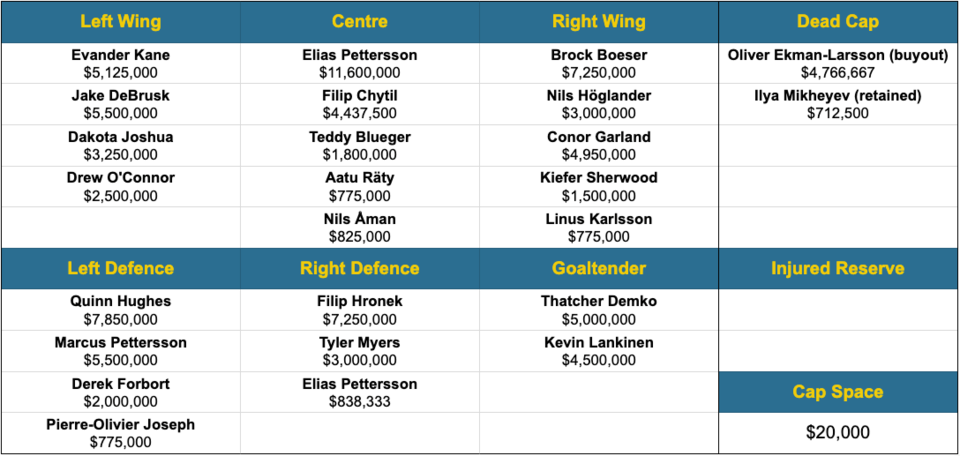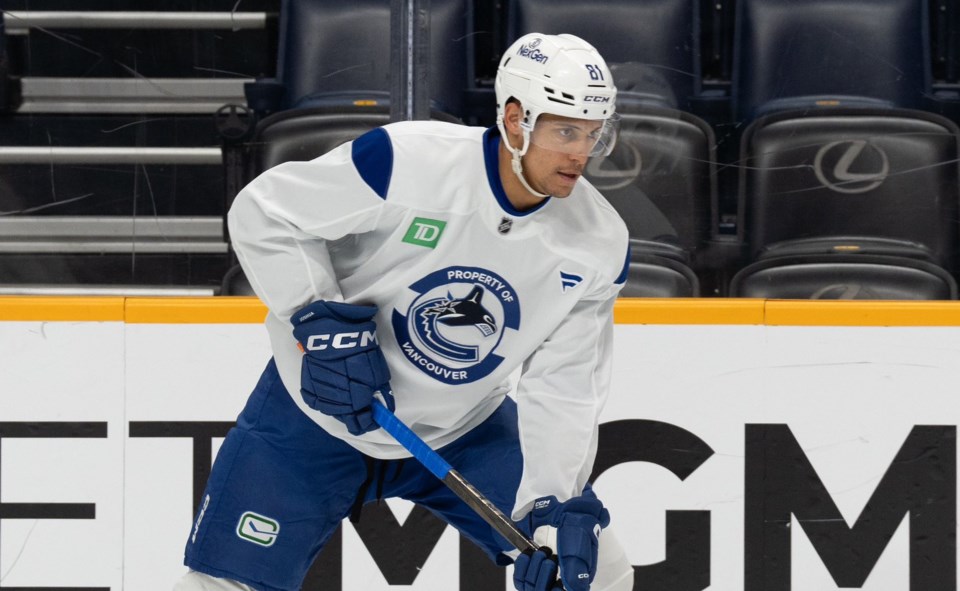The frenzy has died down a few days after July 1, but the Â鶹´«Ă˝Ół»Canucks still have work to do.
So far this offseason, the Canucks have brought in two new players, trading for winger Evander Kane and signing defenceman Pierre-Olivier Joseph to a one-year deal. Their biggest move was to bring back Brock Boeser on a long-term contract.
None of that addresses the Canucks’ biggest need by their own admission: a top-six centre.
The top free agents have all been signed, leaving only a few remaining in the bargain bin with copies of Snow Dogs on DVD for teams to pick through. The odds are low that the Canucks will find a top-six centre there unless they take a flyer on Evgeny Kuznetsov. That leaves a trade as their only recourse.
But in order to assess whether the Canucks can pull off a trade, we need to take stock of where they are currently. Let’s break down the Canucks’ salary cap situation.
The Canucks have just $20,000 in cap space
Here’s a prospective 23-man roster for the Canucks, one that seems like it would be fairly reasonable on opening night. Sure, there could be some minor adjustments around the fringes or some different lines, but not ones that would make a significant difference to the salary cap.

This roster portions out $53,287,500 to the forwards, $27,213,333 to the defence, and $9,500,000 to the goaltenders, with $5,479,167 in dead cap between Oliver Ekman-Larsson’s buyout and the salary retained in the Ilya Mikheyev trade. That’s a total cap hit of $95,480,000.
That leaves the Canucks with just $20,000 in cap space.
To be clear, teams can go over the salary cap by up to 10% — $9.55 million — during the offseason, so the amount of current cap space is a bit of a moot point, but it shows the challenge the Canucks face if they want to add another forward to their roster.
The Ekman-Larsson buyout certainly hurts. That ~$4.8 million in dead cap would go a long way towards paying a second-line centre. For instance, reported Canucks trade target Marco Rossi is projected to have a $4.5 million cap hit on a two-year bridge contract.
That particular milk has already been spilt, however. As it is, the Canucks will have to move money out in a trade if they want to add a centre.
Who could the Canucks trade?
There are a few players who jump out when looking at the Canucks’ cap hits, namely a few bottom-six wingers getting paid a bit more than necessary: Dakota Joshua ($3.25 million), Nils Höglander ($3 million), and Drew O’Connor ($2.5 million).
If one of those wingers can play in the top-six or provide high-end third-line value, then that’s money well spent. Otherwise, that’s money that might be better allotted to the centre position.
The Canucks can potentially afford to move a winger or two because they have prospects champing at the bit in the AHL. Arshdeep Bains, Linus Karlsson, and Max Sasson will be competing for jobs in training camp, with all three on league-minimum $775,000 deals.
If Joshua, for instance, is traded, O’Connor can step up into that third-line spot, with Bains, Karlsson, and Sasson ready to step up onto the fourth line.
As for the defence, there aren't really any players that make sense to trade, unless you turn to one of the team's prospects. Tyler Myers is seen as a key piece of the team's veteran leadership, while Derek Forbort is prized for his penalty killing and steady defensive game.
It should be noted that the Canucks will have to do some cap juggling if they want Tom Willander or Victor Mancini on the opening-night roster. Willander will have a $950,000 cap hit, while Mancini is at $870,000, so even swapping out a forward like Åman for a defenceman would put the Canucks over the cap.
Of course, that’s a problem that might be solved on its own, as there are always unexpected injuries in the offseason and training camp. That’s not something that can be counted on to make room for a top-six centre, but it can certainly free up a little bit of space for minor moves.
Looking at all of this together, however, it becomes clear why general manager Patrik Allvin emphasized that the team feels comfortable with Elias Pettersson and Filip Chytil as their top-two centres.
"Adam [Foote] felt very confident starting the season with Petey and Chytil as the number one and two," said Allvin on July 1.



